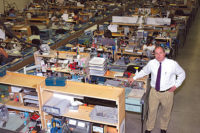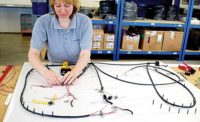After a wire harness has been assembled, groups of wires are typically bundled with tape, heat-shrink tubing, plastic sleeves or, most commonly, cable ties. A good-sized harness can require dozens of them.
Cable ties can be installed in one of two ways. An assembler can manually wrap the tie around a group of wires and then use a hand-powered tool to cinch the tie snug. (Depending on the tool, a handheld clipper may then be needed to trim the tail flush with the head.)
Alternatively, an assembler can use a handheld pneumatic or electric tool that automatically wraps, tightens and trims the tie in one go.
The former is light, inexpensive and easy to use. The latter is faster—a good tool can install a cable tie in less than a second—but it’s also considerably heavier and more expensive. Either way, engineers are well-advised to keep ergonomics top-of-mind.
“When you’re applying hundreds or thousands of these ties, that’s when problems develop,” says Jay Kapellusch, Ph.D., assistant professor of occupational sciences and technology at the University of Wisconsin—Milwaukee (UWM).
If engineers opt for the hand-powered option, they should look for a lightweight tool that fits comfortably in the hand and does not require much grip-force to operate. When installing cable ties, grip force, frequency, duration and posture combine to put assemblers at risk of hand and wrist injuries. Engineers may not be able to address all those risk factors, but they can at least find a tool that needs minimal force to tension a tie.
“Force is a big deal,” says Kapellusch, a researcher at UWM’s Center for Ergonomics. “A small amount of force can help out a lot.”
Engineers can do away with the need to manually apply force to a cable tie by opting for a power tool, but Kapellusch warns they could end up swapping one set of musculoskeletal problems for another.
“The problem is, a power tool is heavier [than a hand tool],” he explains. “The shoulder joint is surprisingly weak. Anything more than 2.5 pounds becomes a problem if you have to use it repetitively, especially if you have to move the tool around a lot, which is typically the case with a cable-tie tool.”
DESIGNING THE PERFECT TOOL
Ergonomics was a key consideration when HellermannTyton was developing its new, manually powered cable-tie installation tool, the EVO 7. The handle keeps the wrist in an upright, neutral position. Contoured to fit the palm of the hand, the handle is made from a soft, nonslip material with a built-in air cushion to reduce pressure points. The soft-touch trigger has individual finger grips for greater comfort and control. And, the grip span can be set to two positions: standard and short, for smaller hands.
The housing is made from a lightweight, impact-resistant composite, and the tool weighs in at just 9.7 ounces. A long narrow nose lets operators cut ties in tight spaces, and a wide, tapered entry point facilitates insertion of each tie.
When designing the tool, HellermannTyton sought input from customers worldwide, as well as the research team at UWM’s Center for Ergonomics.
“I really admire the design of that tool,” admits Kapellusch. “They did a fantastic job.”
A key feature of the tool is the tension, lock and cut mechanism (TLC). “Most tools...continue stretching the tie during the cutting process,” explains Ed Dyer, vice president of engineering at HellermannTyton and the chief inventor of the EVO 7. “The TLC tensions the tie, but then it locks, stopping the tensioning process. It then sends the blade through the tie.
“That has a whole bunch of benefits. The main benefit is that it eliminates the shock or impact on your hand during the cut-off process. It also increases blade life, because you’re not dragging the tie across the blade during the cutting process. It reduces the peak stress on the tie during cut-off, because it only pulls the tie tight enough to achieve the desired tension. And, it provides a more consistent cut-off, because it pulls to a certain point and stops. If you set the tool [for] 80 newtons, you have consistent cut-off at 80 newtons again and again.”
HellermannTyton’s engineers focused on several other features besides ergonomics. One was tension control. A dial at the back of the tool can be set to 33 tension settings—including zero.
“In some regions, they want to apply cable ties with no tension, so they don’t squish sensitive conductors,” says Dyer.
To ensure consistent tensioning, each tool is calibrated at the factory after assembly. Engineers can also recalibrate the tool themselves, if necessary. To simplify maintenance, the blade can only be installed one way.
PUTTING TOOLS TO THE TEST
HellermannTyton’s engineers thought they had a pretty good design in the EVO 7, but was it really? There was only one way to find out. They hired Kapellusch and his team at the Center for Ergonomics to scientifically test the tool against three competing models.
The UWM study involved 24 subjects (12 male and 12 female), four manually powered cable-tie tools, and three strengths of cable ties (18, 30, 50 pounds).
The primary objectives were to determine:
- the amount of grip force applied during tool use.
- level of perceived stress during tool use.
- how comfortable each tool was to use.
- the amount of kickback during tool use.
- ease of applying cable ties using each tool.
- how often and how severely did each tool pinch the hand during use.
Applied grip force was estimated using surface electromyography data from six forearm muscles. Subjective measurements, such as comfort and ease of use, were rated on sliding numerical scales.
Applied grip force requirements for using the tools ranged from 27.8 to 46.5 pounds. The EVO 7 consistently required less force than the other tools, with a maximum difference of 10.1 pounds less force when applying 50-pound cable-ties. The three competing tools required similar levels of force for each tool-tie combination.
“Quite honestly, I didn’t expect the force differences between the tools to be quite as large as they were,” says Kapellusch.
Subjects rated the tools between “very light” and slightly more than “hard” on a numerical perceived exertion scale. The competing tools received similar ratings, while the EVO 7 received relatively lower ratings.
Handle design, kickback, and grip effort required to use the tool appear to have a strong effect on perceived comfort. The tools with rounded handle designs were all rated as comfortable, while a tool with a squared handle design was rated as uncomfortable for stronger ties. The EVO 7 was rated as most comfortable, possibly due to its consistently lighter grip force requirements, lack of hand pinching, and minimal kickback during use.
When asked to rank-order the four tools based on overall preference, overall comfort, ease of setting tension, and overall ease of use, subjects consistently ranked the EVO 7 as best.
When evaluated using a numerical strain index, the EVO 7 resulted in more “low-risk” working scenarios than the other three tools tested. This suggests that using the EVO 7 could help to reduce the risk of hand and wrist injuries during harness assembly.









